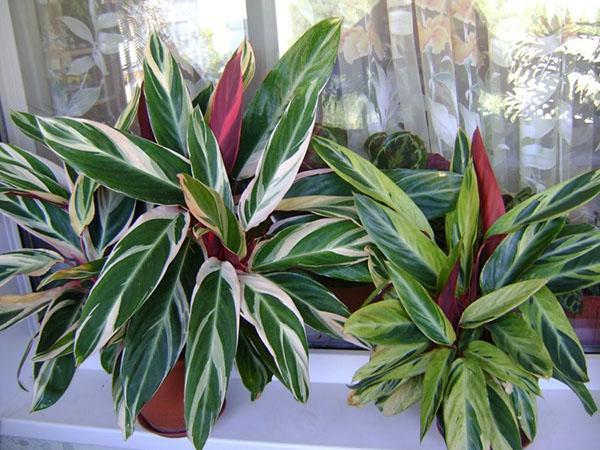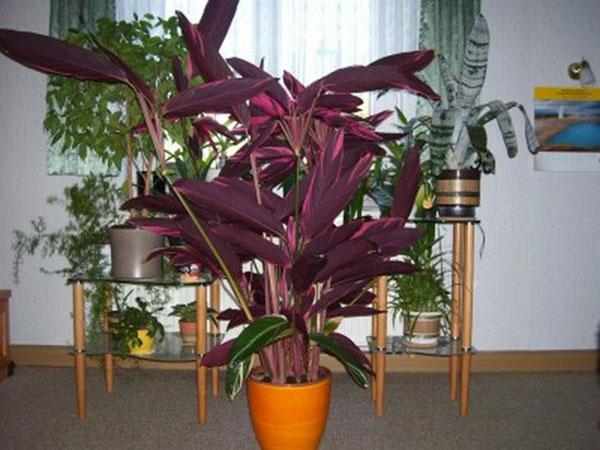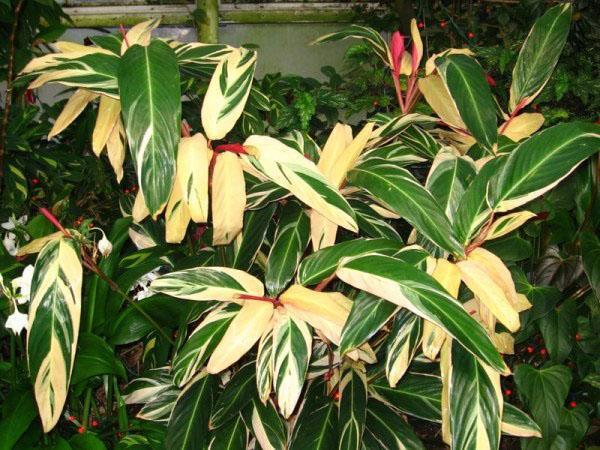Description of popular types of stromant
 Today, many indoor floriculture lovers pay attention to exotic plants. To decorate an apartment, the types of stromant that are most suitable for growing indoors will be an excellent option. Skillful selection of plants, adherence to the rules for caring for them will help to revitalize the interior with the help of bright colors and greenery.
Today, many indoor floriculture lovers pay attention to exotic plants. To decorate an apartment, the types of stromant that are most suitable for growing indoors will be an excellent option. Skillful selection of plants, adherence to the rules for caring for them will help to revitalize the interior with the help of bright colors and greenery.
General information
Stromanta is a perennial ornamental plant from the Marantov family. An alien from the South American continent is distinguished by a spectacular and non-standard appearance. Beautiful, smartly colored leaves look like stylish decorations or colorful birds. About 15 different species of stromant are known, growing mainly in the wild. For decorative cultivation, only a few of them are used.

All types of stromant are characterized by the ability to change the position of their leaves in the plane. Due to the peculiarities of the petiole, they can turn towards the sun. At the same time, the bush is transformed, becoming instead of a variegated green emerald-burgundy and takes on an unusually elegant look. Although the movements of the plant themselves are imperceptible, the amplitude of the leaves is very clearly visible during the day, which makes the flower look like a living organism.

The unusual behavior of the flower is simply explained. The base of the leaf contains a pigment that can control the position of the leaf plate depending on the intensity of the sun's rays.
In the evening and morning hours, in order to get enough light for the process of photosynthesis, the stromant turns the leaves with the surface towards the sun. At noon, when the sun is brighter, unfolds them edge-on to avoid burns and reduce moisture loss.
For such an interesting feature, the representatives of the Marantovs are also called "prayer plants". The leaves, rising vertically, resemble the hands of a person folding during prayer.
In indoor conditions, flowering of stromant can be seen on rare occasions. The long peduncle covers many small white flowers with bright red bracts. The room is filled with an extraordinary pleasant aroma.
This beauty has one drawback - at the end of flowering, the leaves lose their attractiveness. The plant takes a long time to restore its former beauty.
Types and varieties of stromant
Of the existing natural plant species in indoor breeding, only pleasant stromant and bloody stromant, including several different varieties, have become widespread.
Stromanta is pleasant
 An ornamental evergreen plant, 15 to 30 cm high. Oval-shaped leaves are located on long petioles. Their size is about 20 cm. The outer surface of the sheet has a peculiar color. The light green background is lined with emerald stripes alternating with lighter ones.They extend from the midrib in a herringbone pattern, which makes the leaves surprisingly beautiful. Thanks to this ornament, the plant is easily recognized among other types of stromant. The back of the leaf blade is no less beautiful - grayish-green in color with a pink tint.
An ornamental evergreen plant, 15 to 30 cm high. Oval-shaped leaves are located on long petioles. Their size is about 20 cm. The outer surface of the sheet has a peculiar color. The light green background is lined with emerald stripes alternating with lighter ones.They extend from the midrib in a herringbone pattern, which makes the leaves surprisingly beautiful. Thanks to this ornament, the plant is easily recognized among other types of stromant. The back of the leaf blade is no less beautiful - grayish-green in color with a pink tint.
Those who want to grow stromanthe amabilis in their apartment should be more careful when buying. Often a plant is distributed under this name ktenante pleasant (ctenanthe amabilis), not related to stromants. Its height usually does not exceed 25 cm, leaves are wide, oval in shape with a light outer surface and a silvery inner side.
Bloody stromant
 Often there is a plant called blood-red stromanthe (Stromanthe sanguinea). Place of origin - Brazilian rainforests. The plant is much larger than other species indoor stromants... Leaves in the shape of an ellipse with a slight taper at the top. With proper care, they grow up to 40 cm long. The ornament on the surface of the leaf resembles the letter V. Its color is dark emerald, which looks very beautiful against a light green general background. On the back, the leaf color is no less beautiful - from light cherry to rich burgundy.
Often there is a plant called blood-red stromanthe (Stromanthe sanguinea). Place of origin - Brazilian rainforests. The plant is much larger than other species indoor stromants... Leaves in the shape of an ellipse with a slight taper at the top. With proper care, they grow up to 40 cm long. The ornament on the surface of the leaf resembles the letter V. Its color is dark emerald, which looks very beautiful against a light green general background. On the back, the leaf color is no less beautiful - from light cherry to rich burgundy.
This species includes several varieties that are very similar in the shape of the leaves and differ only in colors and patterns:
- Stromanta Triostar. Another name for it is tricolor. Dark emerald colored leaves are decorated with pink, white, light green stains. The reverse side is tinted in burgundy color.

- Stromanta Multicolor. The pattern on the upper part of the sheet is represented by numerous light spots, stripes on a dark green background.

- Stromanta Maroon. On the bright greenery, the middle vein is clearly distinguished, which has a lighter color. The plant cannot boast of high decorativeness, therefore, it is grown less often as a pot culture than other varieties.

- Stromanta Horticolor. The leaves of this type of stromant are colored with stripes and spots of various colors - olive, yellow, various shades of green.

- Stromanta Stripe Star. The general background of the leaf blade is bright green. A light stripe is clearly visible along the midvein. The lower surface of the leaf has a rich burgundy color.

These are the most suitable species and varieties for indoor cultivation, which, despite the capricious nature of the plant, take root well in city apartments. With proper care, the right location, the stromant plant can become a decoration of any home.